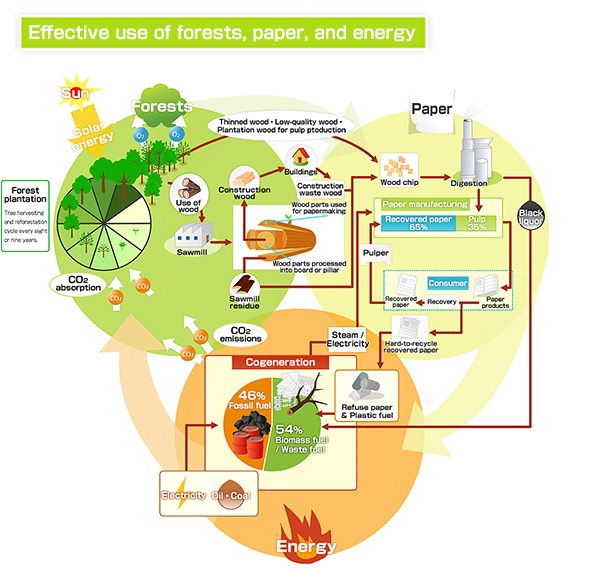 About Recycling-based Industry | General Perspective
About Recycling-based Industry | General Perspective
The paper industry is a material-recycling-based industry.
Paper has evolved together with human history and is indispensable in modern society. The paper industry does not only supply a variety of paper products stably, but also integrates “forests,” “paper” and “energy” into a sustainable cycle and makes effective use of resources.
Effective use of forests
It is very well known that paper is made from wood. Wood is an excellent renewable resource. Under the mission of “sustainable forest management,” the Japanese paper industry has worked to utilize, nurture and preserve precious forest resources until coming ages. For example, the industry actively uses lumber remnants that are difficult to be utilized effectively for architecture, etc. The industry does its best to minimize waste from forest resources. In the same token, the industry has been actively engaged in forest plantation activities to grow forests and protect the environment by adhering to the principles of “always plant after felling” and “increase area by appropriate rejuvenation intervention.”
Effective use of recovered paper
Utilizing that paper is an easily recyclable material, the paper industry has established a system of recycling recovered paper into new paper products. The use of recovered paper contributes to the reduction of waste and to the effective use of resources.
As a producer of paper, and simultaneously, as a consumer of recovered paper, the Japanese paper industry makes further efforts to maximize the use of recovered paper, further improve the recycling technology and expand the use of recycled paper, so that we can perform the responsibilities expected of us in the recycling chain of resources.
Effective use of energy
The paper industry also helps increase the effective recycling of the energy and the waste generating from the papermaking processes. The waste liquid that comes out of the pulp manufacturing process from wood (“black liquor”), waste wood, and paper sludge (organic sludge containing fine fibrous materials) are consumed as biomass energy (organic resources generated from living organisms). In addition, the Japanese paper industry uses energy derived from waste tires and RPF (a kind of refuse derived fuel), thus contributing to the sound recycling of waste. These efforts help reduce the consumption of heavy oil, coal and other fossil fuels, a major source of CO2 emission that aggravates global climate change. The Japanese paper industry has also introduced co-generation systems early on to make use of the steam coming out of boilers for power generation and for the papermaking process and uses energy without waste.


